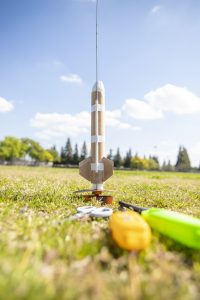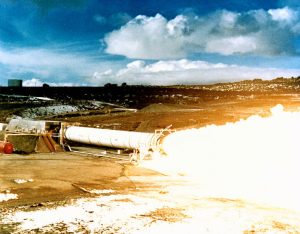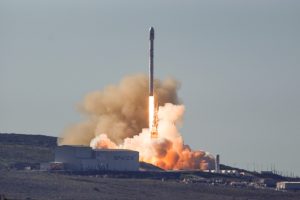Juniors explain the chemistry that makes rockets fly

A few weeks ago, our Zed rocket lifted off the launch pad for the first time. At the heart of our homemade rocket is a homemade engine, which provides the thrust needed to make any rocket fly. In this blog, we’ll describe the chemistry that makes different rocket engines work, and what the reader needs to know to safely make their own engines.
As we covered in blog No. 3: basic rocket science, rockets work by accelerating mass downward. For almost every rocket, this mass is a gas, though some rockets do use water or plasma.
So the question boils down to forcing a lot of gas moving downwards as fast as possible. Chemical rockets do this by burning a dense substance, either liquids or solids, and releasing the hot, pressurized exhaust out a nozzle. How efficient an engine is at doing this is measured by units of Specific Impulse, which essentially compares how hot the exhaust is to how low the molecular weight of the exhaust products is.
Chemical rockets are divided between solid-fueled, liquid-fueled, and hybrid. Solid-fueled rockets typically achieve Specific Impulses, or Isp, between 100 to 300 seconds (“seconds” because Isp is total thrust divided by weight, and total thrust is measured in units of weight-seconds), liquid-fueled are more efficient at 250-450 seconds, and hybrids fall somewhere in the middle.
Solid rocket chemistry

Solid-fueled engines are the simplest in design, as they often have no moving parts. However, the chemistry for solid propellants can get rather complex.
Solid propellants are typically made from four different types of chemicals: fuels, oxidizers, catalysts, and binders. To burn properly, each of these must be mixed in the stoichiometrically correct amounts.
Fuels are made from highly-reactive compounds, such as metals like aluminum, magnesium and zinc, hydrocarbons like sugar and asphalt, or polymers like PVC and rubber. It should be noted that many of these only work with certain oxidizers.
Oxidizers are compounds that contain a high percentage of oxygen, chlorine or nitrogen atoms. When heated to high enough temperature, these compounds will break apart and rapidly oxidize the fuel, creating even more heat. Examples of commonly-used oxidizers include potassium nitrate, potassium perchlorate, and ammonium perchlorate.
Catalysts are chemicals that facilitate faster burning of the fuel and oxidizer, and only make up a small fraction of the mass of the propellant. Binders allow some propellants which would normally be loose powders to stick together and solidify.
Liquid rocket chemistry

Liquid-fueled rockets follow the same basic chemistry as solid rockets, but typically use simpler chemicals. Liquid rockets can use monopropellants, which is where one chemical acts as both oxidizer and fuel, but the most common, and most powerful, type are bipropellant fuels.
As their name suggests, bipropellant rocket engines use two different chemicals, a fuel and an oxidizer. These are pumped at high pressure into the combustion chamber, where they are mixed and burned.
As mentioned before, Specific Impulse increases when the molecular weight of the exhaust is lowered. This is one of the reasons liquid oxygen, O2, is an excellent oxidizer. Other choices include liquid fluorine, which is extremely energetic but ridiculously dangerous, nitrous oxide and hydrogen peroxide.
Choosing a fuel is a balance between density and Isp. Denser fuels, like kerosene, require smaller and therefore lighter tanks to hold, but produce exhaust with a higher molecular weight, lowering Isp. The most common fuels are kerosene and hydrogen, the lightest possible fuel.
Choosing the right propellant
Though there are hundreds of different rocket propellants to choose from, selecting the right one is not as hard as it may sound. From the amateur perspective, cost and complexity exclude using liquid or hybrid designs, and there are only four solid propellants, safe enough, cheap enough and powerful enough to be considered.
Blackpowder: If you buy a model rocket engine, chances are it contains blackpowder. Blackpowder is the original rocket fuel, invented by the Chinese in the 13th century. Blackpowder has the advantage of a high burn rate, but needs to be tightly packed in the motor. If you want to use blackpowder, you are probably better off buying motors from Estes and other model rocket companies, since these have perfected their recipes with dozens of additives and catalysts.
Sugar/Potassium Nitrate: Also known as Rocket Candy, this is the most popular choice for amateurs making their own rockets. Rocket Candy is cheap (about 50 cents for a 100g batch), and easy to make. However, while the final product is safe to handle, making Rocket Candy requires heating the sugar and potassium nitrate, so safe procedures should be followed. Sugar fuels can deliver an Isp of around 120 seconds.
Zinc/Sulfur: Probably the simplest solid rocket fuel, Zinc/Sulfur is one of the oldest amateur rocket fuels. It carries the same disadvantage as blackpowder in that it is a powder, which means a lot of the fuel ends up burning in the exhaust plume rather than inside the motor. ZS burns very fast, but delivers an Isp under 100 seconds.
APCP: Short for Ammonium Perchlorate Composite Propellant, APCP is one of the most powerful fuels but also one of the safest to handle. APCP powers the Space Shuttle SRBs, ejector seats, and ICBMs. The major downside of APCP is the cost, but if an amateur is able to spend a couple hundred bucks and buy the ingredients in bulk, APCP delivers an impressive Isp above 200 seconds.
In our next blog, we’ll talk about the importance of keeping a notebook in amateur rocketry. As always, our goal with these blogs is to inspire the reader to join us in building rockets. A great resource for learning more about amateur rocketry is Richard Nakka’s website.
Visit our site at fcrocketprogram.wordpress.com for more details and updates.
Andrew Rieker can be reached via email.
Bryce Foshee can be reached via Twitter and via email.







